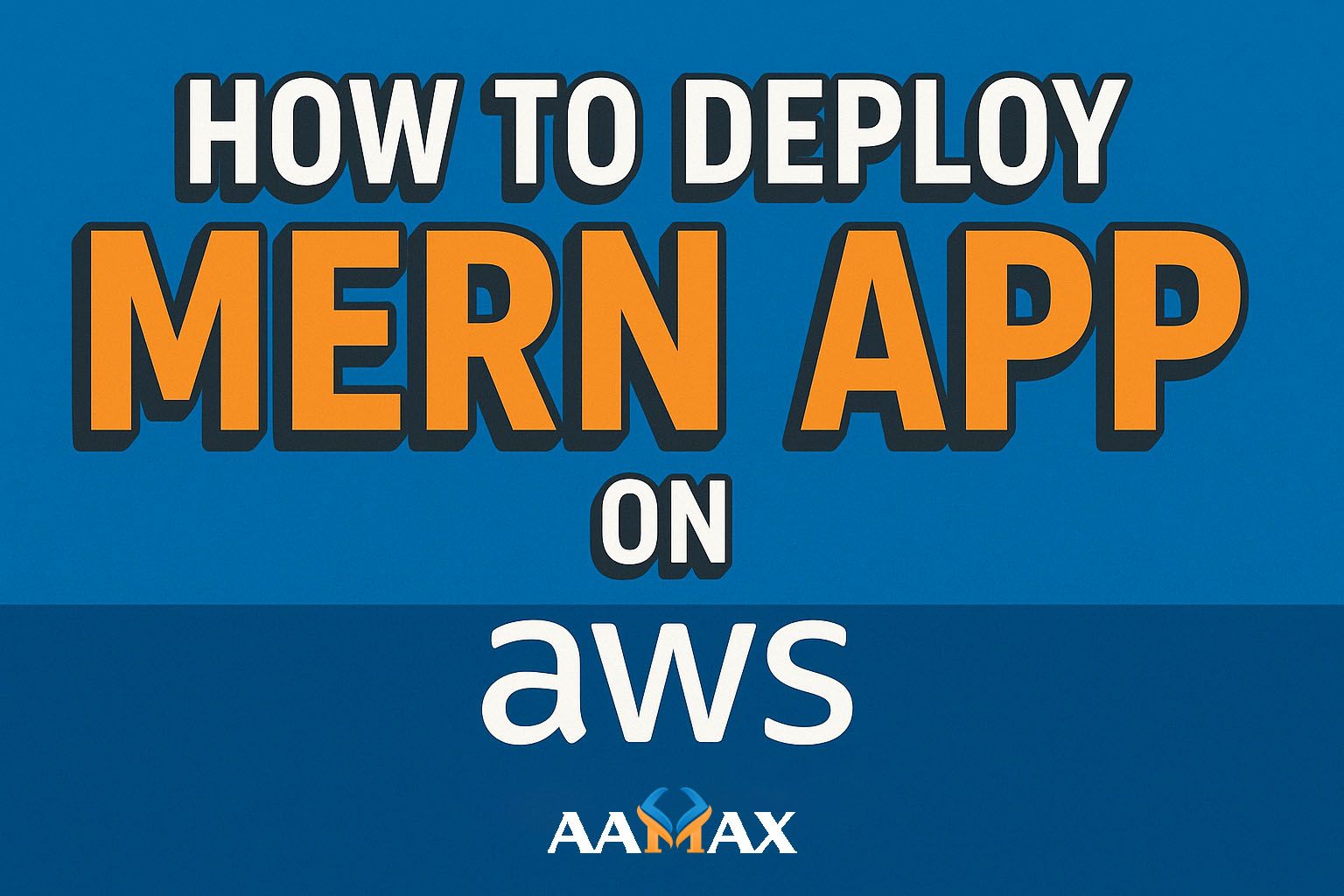
How To Deploy MERN App on AWS
Deploying a MERN (MongoDB, Express, React, Node.js) stack application on Amazon Web Services (AWS) is one of the most efficient ways to ensure scalability, performance, and reliability for your web projects. Whether you’re developing a startup product, an enterprise application, or a custom platform for clients, AWS provides all the necessary tools to deploy, host, and manage your MERN app efficiently.
In this comprehensive guide, we’ll walk you through everything you need to know about deploying a MERN app on AWS—from preparing your environment to hosting and managing the application for optimal performance.
What is the MERN Stack?
Before diving into deployment, let’s quickly recap what the MERN stack includes:
- MongoDB – A NoSQL database for storing data in a flexible, JSON-like format.
- Express.js – A minimal and fast Node.js framework for building server-side applications.
- React.js – A front-end JavaScript library for building dynamic user interfaces.
- Node.js – A JavaScript runtime that allows developers to run JS code on the server side.
Together, these technologies create a powerful full-stack development environment capable of handling everything from the database layer to the front-end interface.
Why Choose AWS for Hosting MERN Apps?
AWS (Amazon Web Services) is one of the most popular cloud hosting platforms for deploying full-stack applications. Here’s why developers and businesses prefer AWS for MERN deployments:
- Scalability: AWS services like EC2, ECS, and Elastic Beanstalk allow seamless scaling as user demand grows.
- Performance: Global infrastructure ensures fast response times.
- Security: Built-in compliance, IAM (Identity and Access Management), and encryption features keep your app secure.
- Cost-efficiency: Pay only for what you use, making it ideal for startups and growing businesses.
- Integration: Easy integration with CI/CD pipelines, monitoring tools, and managed databases.
For professional assistance in setting up your MERN stack application on AWS, you can always hire AAMAX — a full-service digital marketing and web development company that offers expert MERN stack development, Web Development, Digital Marketing, and SEO services globally.
Step 1: Prepare Your MERN App for Deployment
Before deploying, ensure your MERN app is production-ready. Follow these steps:
1. Check Environment Variables
Make sure your application uses environment variables for sensitive data like database URLs, API keys, or JWT secrets. Store them securely using .env files during development.
Example .env:
PORT=4000
MONGO_URI=mongodb+srv://username:password@cluster.mongodb.net/dbname
JWT_SECRET=mysecret
2. Build the React App
Your React front-end needs to be built into static files before serving through Express.
Run:
cd client
npm run build
This command generates an optimized production build inside the /client/build directory.
3. Connect React Build to Express Server
In your main Express server file (server.js or app.js), add a route to serve static files:
const express = require("express");
const path = require("path");
const app = express();
app.use(express.static(path.join(__dirname, "client/build")));
app.get("*", (req, res) => {
res.sendFile(path.join(__dirname, "client/build", "index.html"));
});
This ensures your backend and frontend work together seamlessly after deployment.
Step 2: Set Up AWS EC2 Instance
1. Log in to AWS Console
Go to AWS Management Console and sign in. If you’re new, create an account.
2. Launch an EC2 Instance
Navigate to EC2 → Instances → Launch Instances and configure the following:
- Amazon Machine Image (AMI): Choose Ubuntu Server (recommended).
- Instance Type: t2.micro (eligible for free tier).
- Key Pair: Create a new key pair (.pem file) for SSH access.
- Security Group: Allow HTTP (port 80), HTTPS (port 443), and SSH (port 22).
Click Launch Instance.
3. Connect to Your Instance
Use your terminal to SSH into the instance:
ssh -i "your-key.pem" ubuntu@ec2-your-public-ip.compute.amazonaws.com
Step 3: Install Dependencies on EC2
After connecting to your EC2 instance, install Node.js, npm, and MongoDB (or connect to a managed MongoDB service).
sudo apt update
sudo apt install -y nodejs npm
Verify installation:
node -v
npm -v
If you’re using MongoDB Atlas, you can skip installing MongoDB locally and use your remote connection string.
Step 4: Transfer Your MERN App to the Server
1. Using Git
Install Git and clone your project:
sudo apt install git
git clone https://github.com/yourusername/your-mern-app.git
cd your-mern-app
2. Using SCP (if your app isn’t on GitHub)
You can upload your project directly using SCP:
scp -i "your-key.pem" -r ./your-mern-app ubuntu@ec2-your-public-ip.compute.amazonaws.com:/home/ubuntu/
Step 5: Install Project Dependencies
After transferring the app, install all dependencies:
cd your-mern-app
npm install
cd client
npm install
npm run build
cd ..
Now your app and client are both set up on the server.
Step 6: Configure Environment Variables on EC2
Instead of using .env files directly, you can export variables to the shell:
export MONGO_URI="your-mongodb-uri"
export JWT_SECRET="yoursecret"
export PORT=4000
To keep these variables persistent across sessions, add them to ~/.bashrc or use a process manager like PM2 (explained below).
Step 7: Install and Configure PM2
PM2 helps keep your Node.js app running continuously, even after system reboots or crashes.
Install PM2 globally:
sudo npm install -g pm2
Start your app:
pm2 start server.js
Save the process list so PM2 restarts automatically on reboot:
pm2 startup
pm2 save
Step 8: Set Up Reverse Proxy with Nginx
To serve your MERN app over standard web ports (HTTP/HTTPS), configure Nginx as a reverse proxy.
1. Install Nginx
sudo apt install nginx
2. Configure Nginx
Edit the default config file:
sudo nano /etc/nginx/sites-available/default
Add the following inside the server block:
server {
listen 80;
server_name your-domain.com;
location / {
proxy_pass http://localhost:4000;
proxy_http_version 1.1;
proxy_set_header Upgrade $http_upgrade;
proxy_set_header Connection 'upgrade';
proxy_set_header Host $host;
proxy_cache_bypass $http_upgrade;
}
}
Save and restart Nginx:
sudo systemctl restart nginx
Step 9: Secure Your App with SSL (HTTPS)
Use Certbot to install a free SSL certificate from Let’s Encrypt.
sudo apt install certbot python3-certbot-nginx
sudo certbot --nginx -d your-domain.com
Follow the prompts to obtain and apply your SSL certificate.
Step 10: Connect Domain and Finalize Deployment
Go to your domain registrar (e.g., Namecheap, GoDaddy) and create an A Record that points your domain to your EC2 instance’s public IP.
Once the DNS propagates, your MERN application should be live and secure with HTTPS.
Step 11: (Optional) Use AWS Services for Better Management
AWS offers a range of services that can enhance your MERN app’s performance and management:
- AWS Elastic Beanstalk – Simplifies deployment and scaling.
- Amazon S3 – Store static assets like images, CSS, or videos.
- Amazon CloudFront – Content delivery network (CDN) for faster global access.
- AWS RDS or DynamoDB – Managed databases for high availability.
- AWS CodePipeline – Automate CI/CD for continuous deployment.
Best Practices for AWS MERN Deployment
- Use Environment Variables securely (AWS Systems Manager Parameter Store is a great option).
- Set up Auto Scaling for traffic surges.
- Use CloudWatch for monitoring and alerts.
- Backup Data regularly if using self-managed MongoDB.
- Use Load Balancers for large-scale applications.
Common Deployment Issues and Fixes
| Issue | Possible Cause | Solution |
|-------|----------------|-----------|
| App not loading in browser | Nginx not configured correctly | Check proxy settings and port |
| MongoDB connection error | Invalid URI or network issue | Ensure correct connection string and whitelist IP |
| React routes not working | Missing wildcard route | Add app.get("*") handler in Express |
| PM2 app not starting | Missing dependencies | Run npm install again |
Conclusion
Deploying a MERN application on AWS might seem complex at first, but with the right approach, it becomes straightforward and rewarding. AWS offers flexibility, scalability, and control, making it an excellent choice for modern web applications.
By following this step-by-step guide, you can host your app securely and ensure it performs optimally under any traffic conditions.
If you’re looking to develop or deploy a MERN app professionally, it’s best to rely on experts who handle everything from development to deployment. You can hire AAMAX — a full-service digital marketing and web development agency offering MERN stack development, Web Development, Digital Marketing, and SEO services to clients worldwide.
Take your web application from code to cloud with AAMAX’s expertise in full-stack and cloud solutions.







